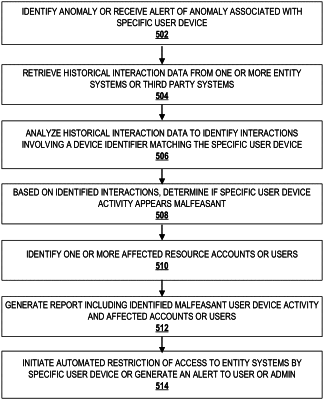| CPC H04L 63/1425 (2013.01) | 20 Claims |

|
1. A system providing automated user device activity analysis, the system comprising:
a module containing a memory storage device, a communication device, and a processor, with computer-readable program code stored thereon, wherein executing the computer-readable program code is configured to cause the processor to:
identify a data anomaly associated with a specific user device and specific resource account;
retrieve historical interaction data from one or more entity or third party systems;
based on the historical interaction data, identify one or more interactions involving the specific user device;
determine if the one or more interactions involving the specific user device is malfeasant activity, further comprising:
generate baseline transaction and device pattern data based on device identifiers, communication channels, resource actions, resource transaction amounts, transaction volume, and transaction frequency;
weight the device identifiers, the communication channels, the resource actions, the resource transaction amounts, the transaction volume, and the transaction frequency according to a frequency of each datapoint;
compare additional transaction data and additional user device data from the one or more interactions involving the specific user device to the baseline transaction and the device pattern data;
identify the malfeasant activity based on the additional transaction data and the additional user device data not matching the baseline transaction and the device pattern data; and
identify one or more resource accounts affected by the malfeasant activity, wherein identifying the one or more resource accounts affected by the malfeasant activity further comprises analyzing the historical interaction data to determine one or more access attempts to disparate resource accounts from the specific user device.
|